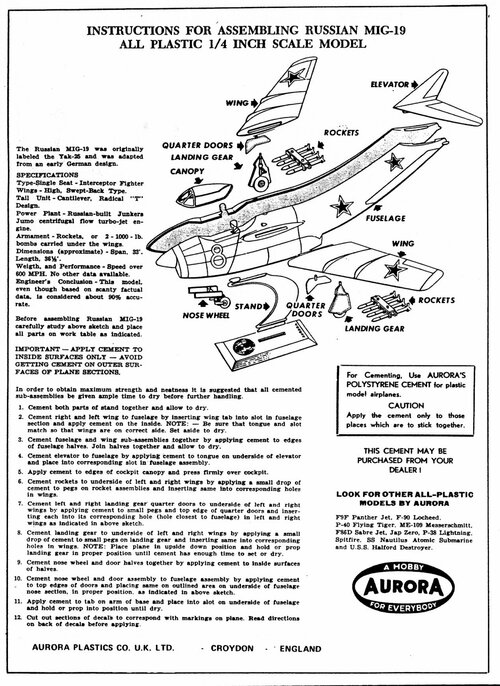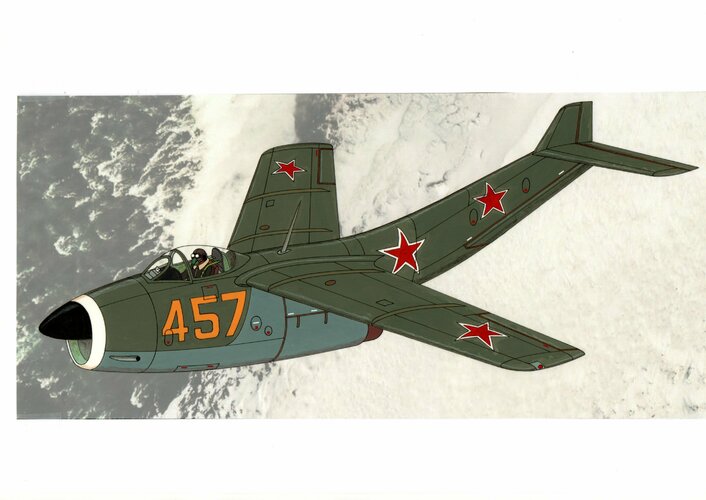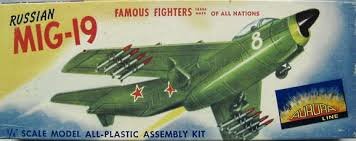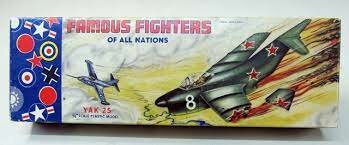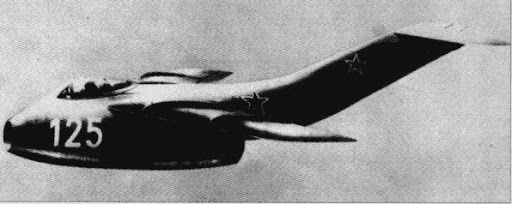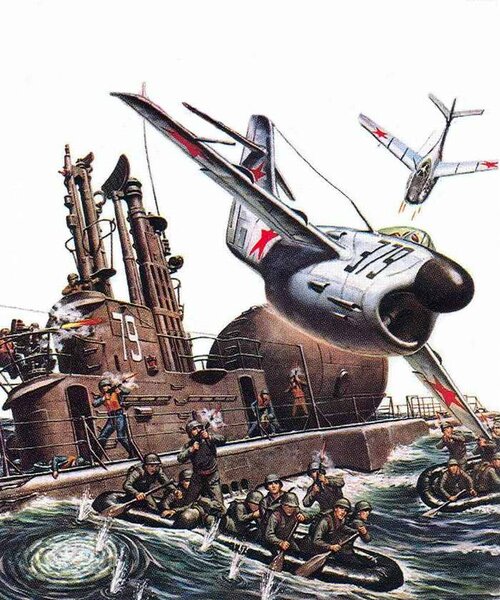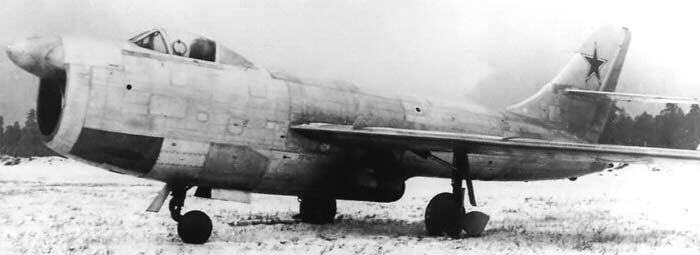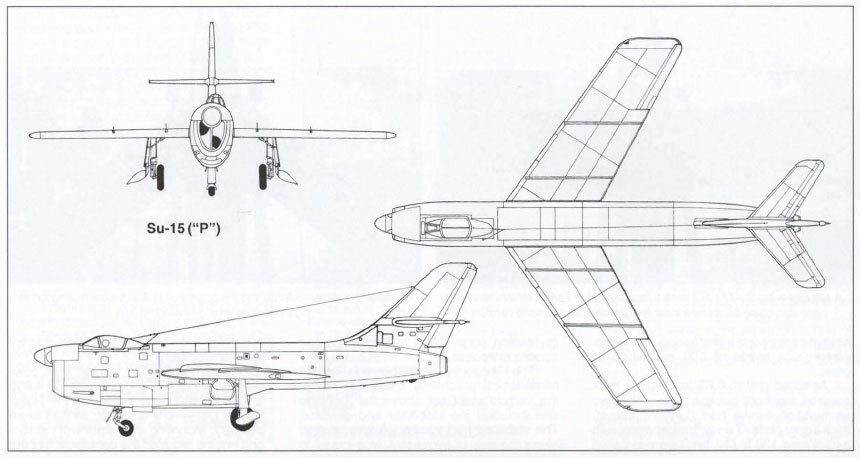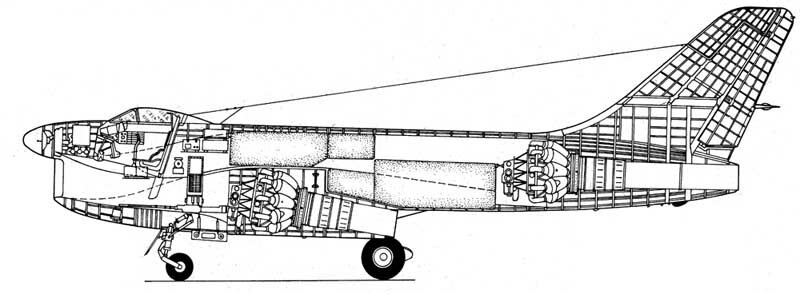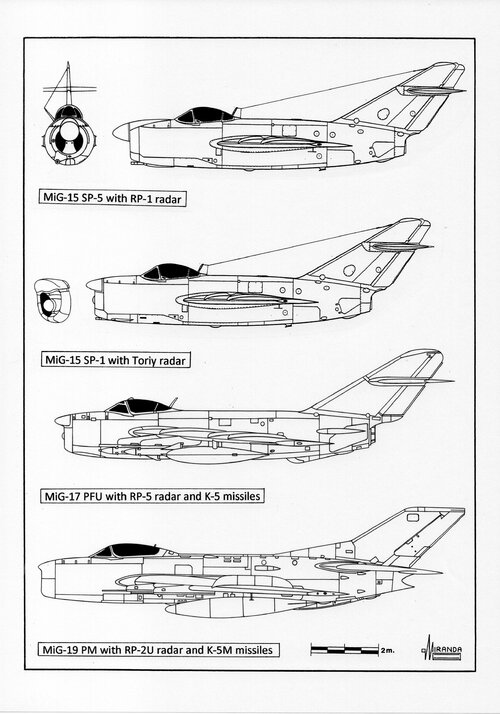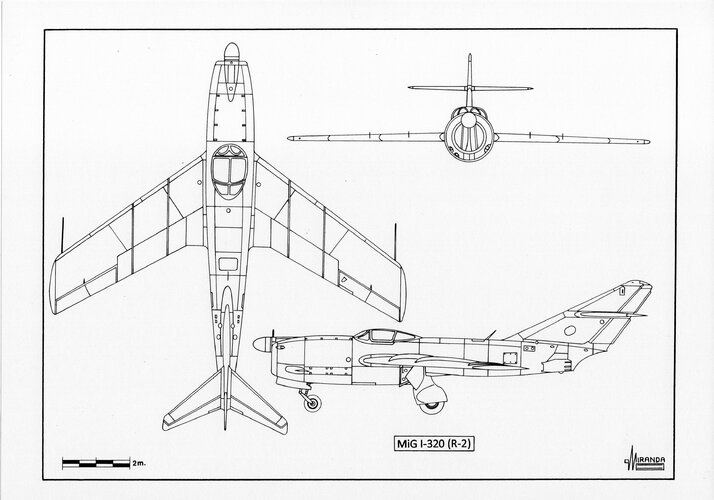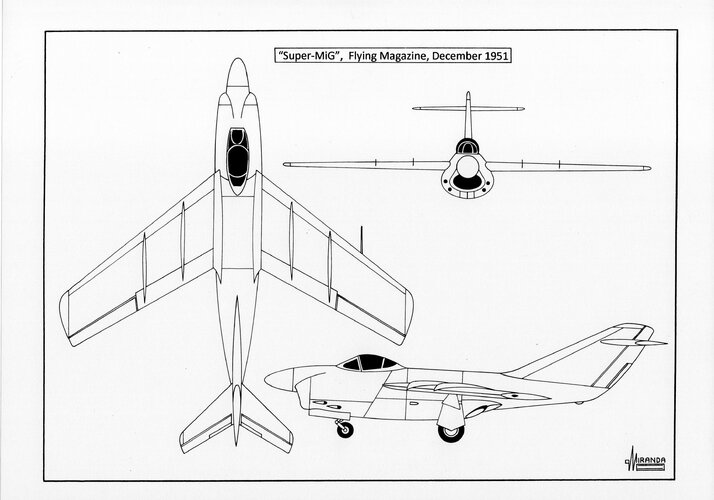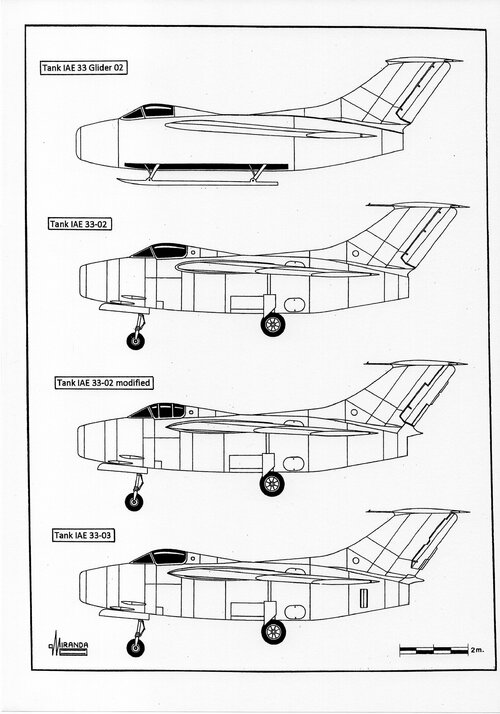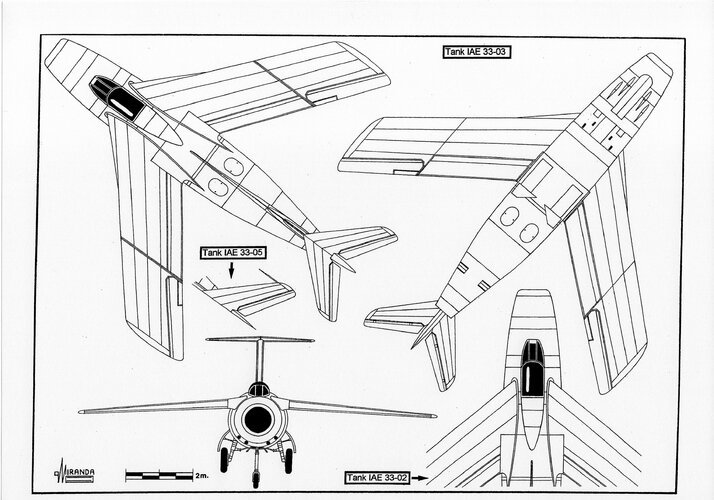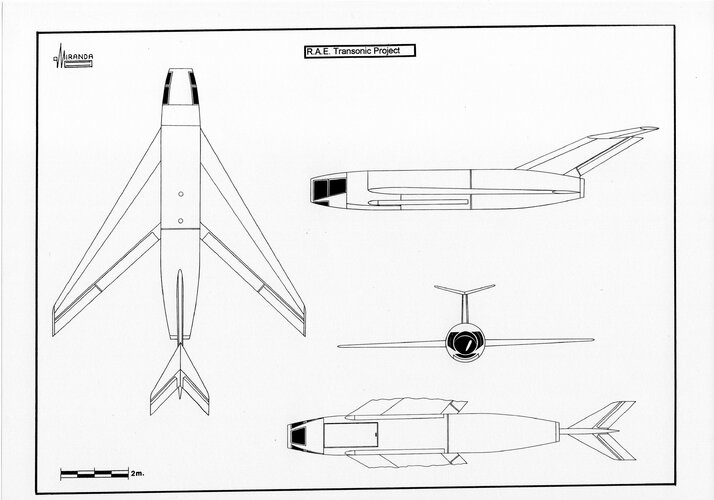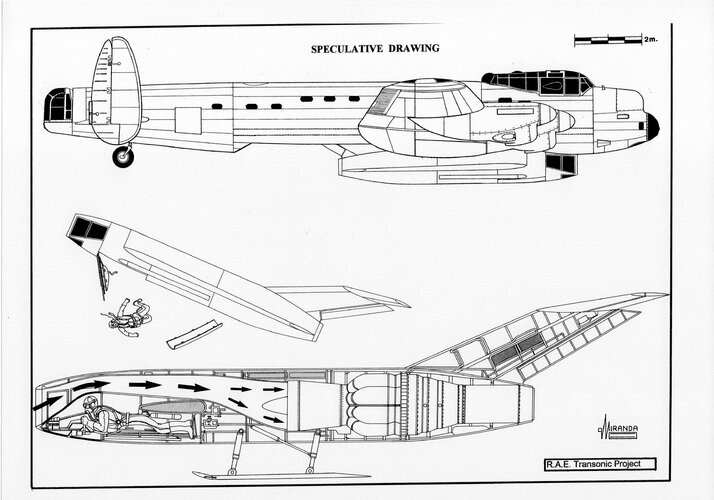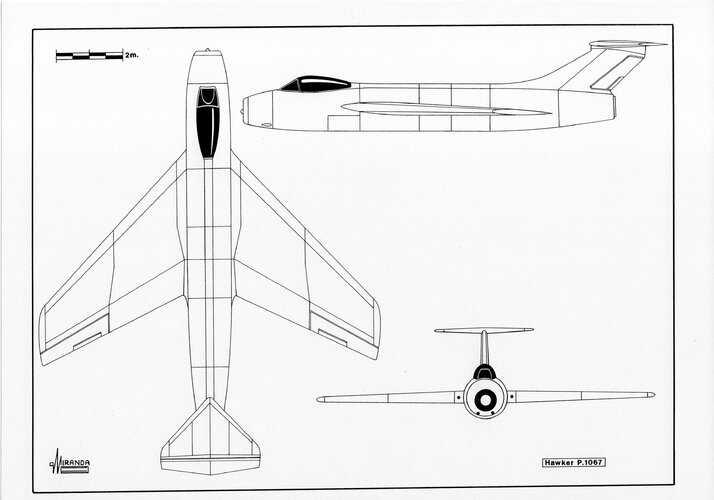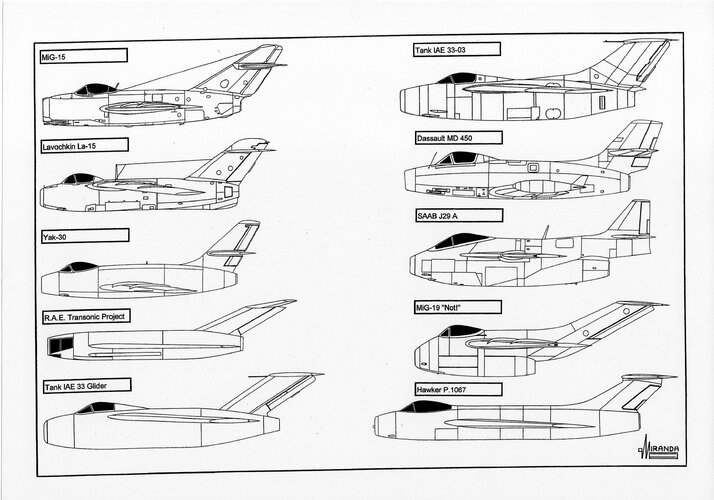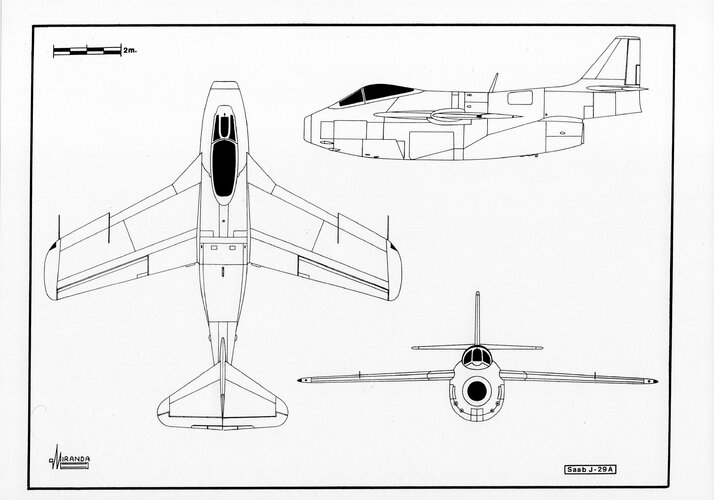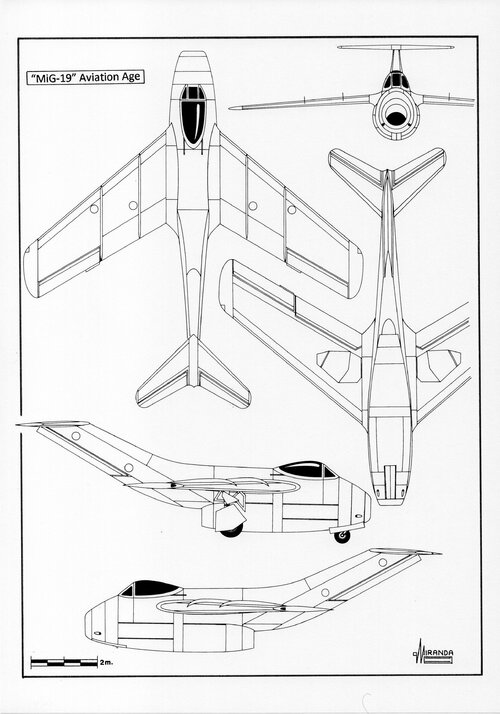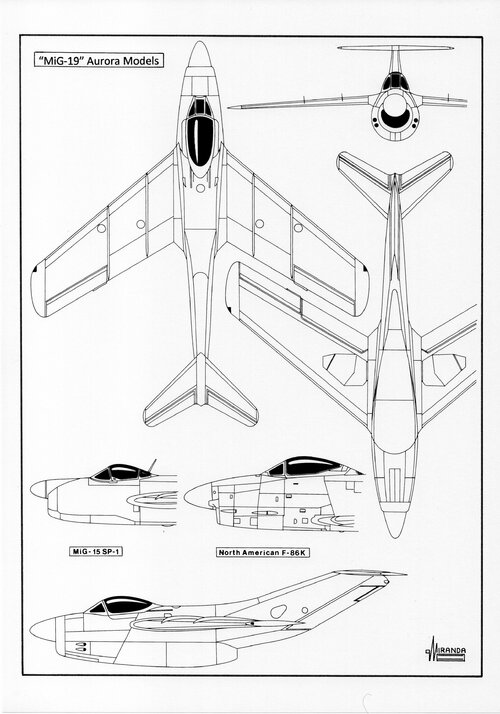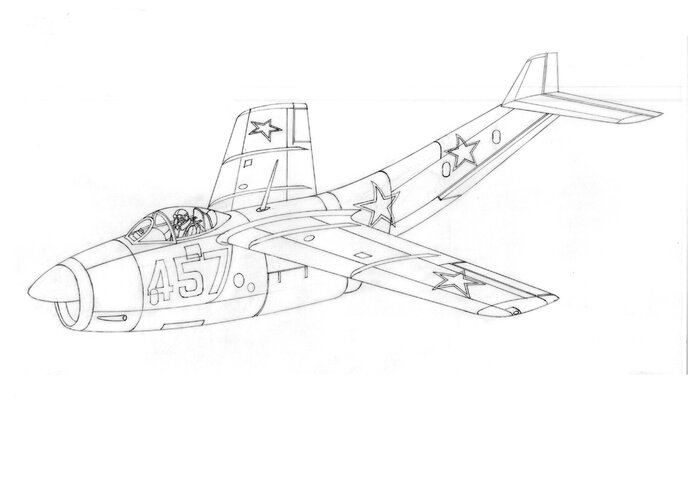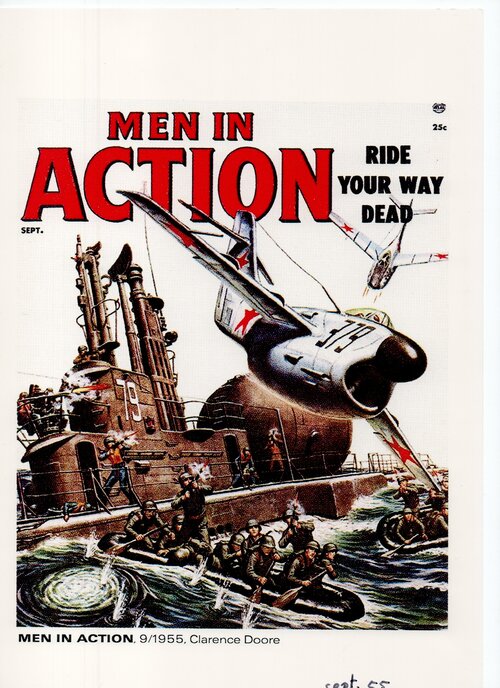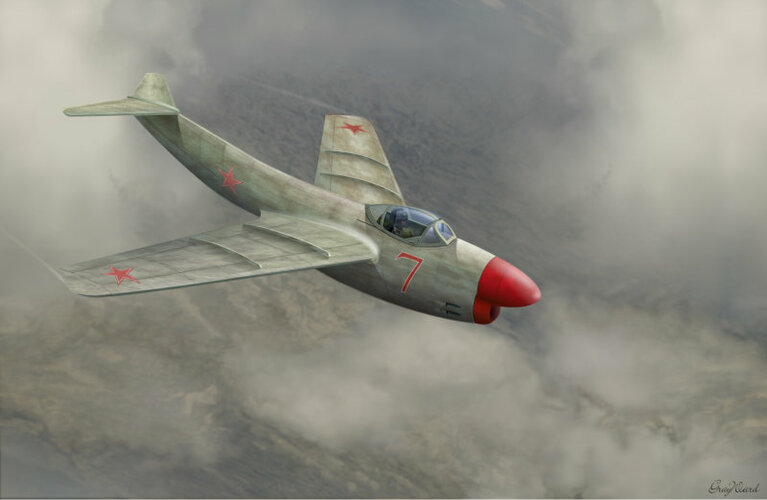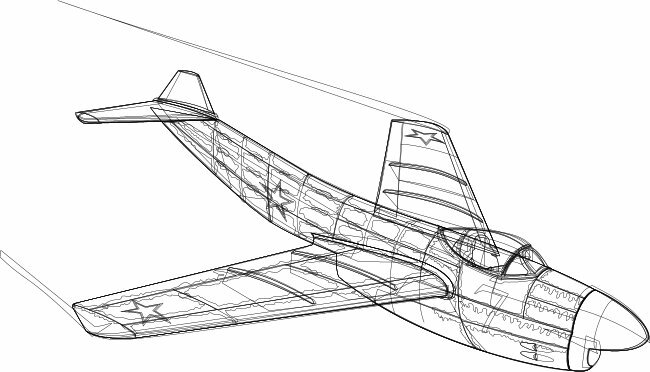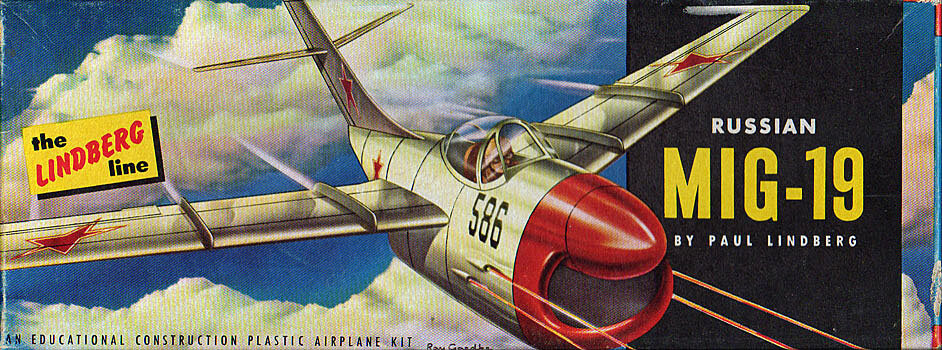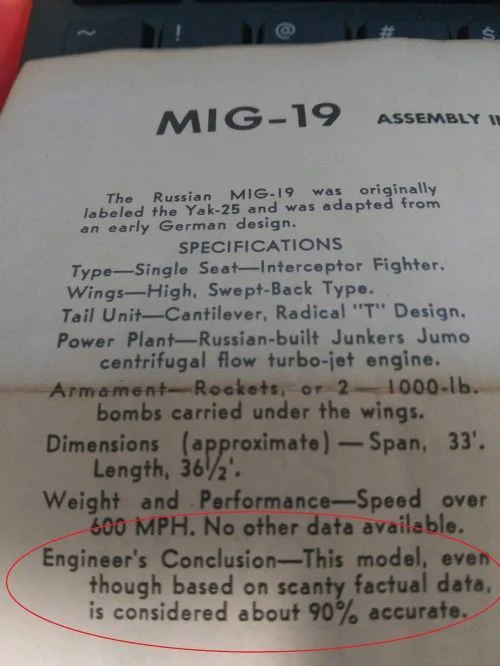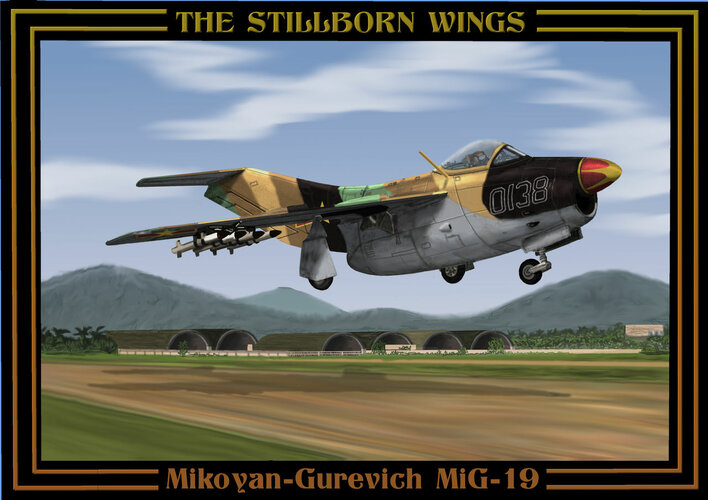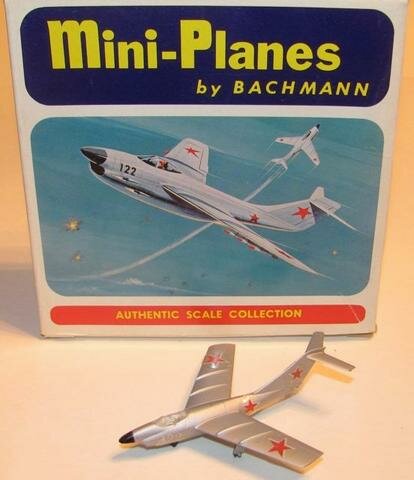You are using an out of date browser. It may not display this or other websites correctly.
You should upgrade or use an alternative browser.
You should upgrade or use an alternative browser.
MiG-19 - Fake
- Thread starter Justo Miranda
- Start date
- Joined
- 3 June 2006
- Messages
- 3,094
- Reaction score
- 3,966
IMHO this plastic model is inspired by the German Focke-Wulf Ta 183.
Airborne2001
ACCESS: Secret
- Joined
- 19 June 2020
- Messages
- 226
- Reaction score
- 284
F.L.
ACCESS: Top Secret
jstar
ACCESS: Secret
- Joined
- 12 October 2007
- Messages
- 346
- Reaction score
- 428
The submarine looks like it was inspired by the USS Perch, only sub to see service in WW II, Korea, and Vietnam. Picture may have been inspired by the Commando raid Perch participated in during the Korean war, when Royal Marines went ashore from her, and blew up some railroad tracks.
southwestforests
ACCESS: Top Secret
- Joined
- 28 June 2012
- Messages
- 759
- Reaction score
- 1,231
Some reverences about the model kit. Was created in 1953.
 www.scalemates.com
www.scalemates.com
and
and

 www.tapatalk.com
www.tapatalk.com
Russian MiG-19, Aurora 66A-79 (1954)
Aurora model kit in scale 1:48, 66A-79 is a rebox released in 1954 | Contents, Previews, Reviews, History + Marketplace | Mikoyan-Gurevich MiG-19 Farmer
and
ABOUT THE DESIGN
In the early 1950s, details of Soviet aircraft were hard to come by. But that didn't stop the then-nascent Aurora Models company from kitting a so-called Russian fighter "inspired" by Nazi Germany's experimental TA-183. First released as the YAK-25 in 1953, the simple model was retooled with missiles, landing gear and surface detail and re-released in metallic green plastic as the MIG-19 a year later. Although the TA-183 did lead to the development of an actual Soviet Fighter -- the MIG 15 -- this particular design was purely fanciful
and

Retro & Nostalgia Scale Modeling Forum-Aurora "Yak-25," aka "MiG-19"
Definitely one of the stranger selections in Aurora's stable of airplane kits was the fictitious aircraft they chose to first call the "Yak-25" then l
Definitely one of the stranger selections in Aurora's stable of airplane kits was the fictitious aircraft they chose to first call the "Yak-25" then later "MiG-19." Of course it was neither, looking more than a stylized interpretation of a late-war Luftwaffe drawing board concept. In any case, it's a pretty neat model!
This one is a Brooklyn issue in characteristic bright green plastic. This issue had neither missiles nor landing gear. The second issue, in a similar green plastic and still labeled Yak-25 introduced those features, along with new box art. Later, the kit was reissued in metallic green plastic and had mysteriously become the MiG-19 (I suspect Revell's issuing a more accurate kit of the real Yak-25 may have had something to do with that!). Finish on this one is polished plastic with canopy framing painted in gloss green acrylic mixed to as closely as possible match the plastic. The white portions of markings were masked and sprayed in mixed yellowed-white Testors enamel with the red handpainted in gloss acrylic. To add a little color, the position lights were foiled then painted with Tamiya clear acrylic. The hardest part of the build was creating a liner and blanking plate for the nose intake! The stand is original to the model and carries the Brooklyn address.
southwestforests
ACCESS: Top Secret
- Joined
- 28 June 2012
- Messages
- 759
- Reaction score
- 1,231
"reverences"?Some reverences about the model kit.
Autocorrect?
southwestforests
ACCESS: Top Secret
- Joined
- 28 June 2012
- Messages
- 759
- Reaction score
- 1,231
Related content: https://www.oldmodelkits.com/blog/p...rly-plastic-model-kit-development-in-the-usa/
SEPTEMBER 2, 2009
Early Plastic Model Kit Development in the USA
Editors Note: every once in a while you run across someone with exceptional knowledge in a certain field. During an email exchange about older kits, I asked Dave if he would mind writing an article about early kits in the US. Dave’s knowledge has been an education to me, and I hope that you enjoy it as well. Alan Bussie
By Dave Fischer
Who made the first plastic model kit in the USA? One of these three companies- Varney, Hawk or Empire- was the first. A later company, O-lin, was significant in early production. We will probably never have an accurate view of the pioneer or the earliest history of the plastic model industry in the U.S. because there was no one innovation that could be described as a starting point. Ideas merged and evolved and eventually came to appear as progress.
The plastic model was not a new idea. In 1934 Dick and Phil Mates, founders of the Hawk Model Company, displayed and sold finished (not kits) plastic models at the re-run of the 1933 Chicago Worlds Fair. In the mid to late 1930s and into World War II, FROG in England had made 1/72 plastic kits cast in acetate plastic and usually including some metal parts. At that time in the U.S., ...
BlackBat242
OK, I changed my personal text ;)
- Joined
- 10 April 2013
- Messages
- 1,482
- Reaction score
- 4,306
southwestforests
ACCESS: Top Secret
- Joined
- 28 June 2012
- Messages
- 759
- Reaction score
- 1,231
When the real deal looks more like a fake than the actual fake does.Su-15 from 1948 (designation later reused for tailed delta-winged interceptor
It is ugly and goofy.
I want one.
southwestforests
ACCESS: Top Secret
- Joined
- 28 June 2012
- Messages
- 759
- Reaction score
- 1,231
Someone sweet talk one of those Asian plastic model companies in to doing one of those in 1/48 scale with internal detail, at least one fuselage half in clear plastic, and a nicely done pilot guy.
Fake MiG-17
In the second half of 1945 the AI radar Gneys-5 passed the State acceptance test.
On February 26, 1946, Tupolev OKB was ordered to design a night fighter version of the Tu-2 fast bomber, with 680 km/h top speed, 10,000 m ceiling, 2,000 km range and Gneys-5S airborne radar. That was enough to intercept the nuclear armed B-29 American bombers.
The Tu-1 prototype flew on March 22, 1947, powered by two AM-43V experimental piston engines, reaching 641 km/h and 11,000 m ceiling. It was mistakenly regarded by NATO intelligence as a likely mass-production type and assigned the Frosty reporting name.
Between March and October 1947, the prototype was flight tested with two types of AI radars: Soviet Gneys-7 and German Telefunken FuG 200 SN-2/SN-2d.
On both types, the transmitting dipoles were in the forward fuselage and the receiving antennas in the wings.
During the tests it was discovered that the glare or Gneys radarscope ruined the night vision of the pilot, who also needed to keep an eye on the airspace around him.
By the time the Tu-1 was flown the prototype of the B-36 American super bomber had already reached 555 km/h flying at 11,280 m.
Therefore, further work on Tu-1 was discontinued.
What the VVS needed at the end of 1947 was a fast jet night fighter with 2,000 km extended range and a second crewmen to take care of the radar.
However the aerodynamic drag generated by the Gneys dipoles and antennas caused an unacceptable loss of speed.
The Bell SCR 720 B AI radar mounted in the Black Widow and D.H. Mosquito NF 36 western night fighters used one parabolic antenna that was installed internally within an aerodynamic radome of dielectric material placed in the nose of the aircraft.
But both the Americans and the British refused to share their centimetric wave lengths technology.
In January 1948 the Soviet Council of Ministers issued a decree calling for a high-performance, long-range, all-weather fighter capable of mounting standing patrols and intercepting the Strategic Air Command bombers far from their targets.
The PVO staff estimated that to achieve this objective a plane with performances similar to those of the MiG-15 would be necessary.
But the fighter would also have to carry a large amount of fuel, a radar of 100 kg and a second crewmen.
To meet the conditions of the specification it would be necessary to use at least two RD-45F centrifugal engines rated at 2,270 kg thrust each, the best turbojet available at the time.
If installed under the wings of the new interceptor, both engines would have generated an unacceptable loss of speed owing to their rather large diameter of 1,273 mm.
Nor would it have been aerodynamically effective to install them under the fuselage belly in side-by-side configuration.
The American long range fighter Bell XP-83 built in 1944 with this basic configuration it had to be canceled due to its poor performance.
The MiG OKB decided to build the I-320 heavy fighter (a 50 per cent scaled up version of the MiG-15) powered by two RD-45F turbojets mounted inside the fuselage in stepped configuration. The forward engine exhausting beneath the fuselage belly and the aft engine exhausting at the tail.
Both turbojets aspirated through the same nose air intake.
This unusual configuration that generated less drag, had already been studied in 1942 by the German designers of the Arado Ar 240 TL heavy fighter project.
And it had also been studied independently by the Japanese designers of the Yokosuka R2Y2 Keiun jet bomber in 1945.
It was expected that the I-320 could operate as high-performance interceptor when the two afterburners were engaged and that could also operate as escort fighter using a single engine to save fuel.
On December 7, 1948, the Council of Ministers issued a decree calling for the development of a new generation of AI radars able to operate on centimetric wavelengths using the German technology of the Telefunken radars FuG 222 Pauke S, FuG 240/3 Berlin N3 and FuG 244 Bremen 0.
The centimetric wavelengths conversion started with the AI radar Slepushkin Toriy which provided search, track and gun-ranging using a single parabolic antenna with 60 cm of diameter.
But Toriy proved to have unreliable and too difficult to use, its manually operated antenna based on that of the FuG 244, has scanning angles of only +30 and -30 degrees and could not operate at the 8g design limit of the I-320.
The radar was designed with a range of 15 km, but during flight tests with the I-320 prototype, it only managed to detect a Tupolev Tu-4 bomber (the Soviet version of the B-29) 7 km away.
The I-320 looked like a MiG-15 with a second turbojet mounted in redan configuration, one radar radome fitted at the top of the nose and a Mosquito-style, two-seat unpressurized cockpit.
The R-1 prototype flew on April 16, 1949, but during the State acceptance trials the plane experienced the same tendency as the MiG-15 to drop a wing at high-speeds.
The appearance of the aerodynamic phenomenon valyozhka (spontaneous rolling) at Mach 0.895 made it necessary to limit its maximum speed, to avoid structural damage.
The R-2 prototype was flown in December 1949 reaching 1,047 km/h top speed and 15,000 m ceiling powered by two VK-1 turbojets rated at 2,700 kg thrust each.
In July 1951 its unreliable Toriy-A was replaced by one Korshun AI radar set, based on the FuG 240/3, which offered better performance although still not adequate.
Both types using manually operated scanners, but the Korshun's parabolic antenna is only 45 cm in diameter and could operate at greater scanning angles.
The VK-1 turbojets proved to be too thirsty and caused the I-320 to only be able to reach the necessary range using two underwing drop tanks.
The I-320 was cancelled in the spring of 1951 in favor of the Yak-25 Flashlight fitted with one Sokol (FuG 222) radar with 1 m of diameter parabolic mirror and powered by two wing-mounted, axial-flow turbojets.
MiG-I-320 R-2 technical data
Wingspan: 46.6 ft. (14.22 m), length: 51.7 ft. (15.77 m), height: 16 ft. (4.88 m), wing surface: 458 sq. ft. (41.2 sq. m), take-off weight: 26,190 lb. (11,864 m), maximum speed: 660 mph (1,047 km/h), ceiling: 49,200 ft. (15,000 m), range: 2,075 km with two underwings drop tanks, equipment: RV-2 radio-altimeter, Barii IFF transponder and RSIU-6 R/T.
Certain information on the MiG I-320 coming from East Germany was filtered to the western press in 1951 and it was interpreted as the description of an advanced version of the well-known MiG-9 with side-by-side axial-flow turbojets, swept wing and tail surfaces.
In December 1951 Flying magazine published an illustration and a three-view drawing of the “Super-MiG/MiG-17” with a landing gear like that of the MiG-15, radar snout and four belly mounted cannon.
According to Flying the new fighter had been identified by USAF in Korea as "flat" MiG.
On February 16, 1953, American Aviation Magazine published an illustration coming from Associated Press Wirephoto depicting an operational "MiG-17" with No. 157.
On April 13, 1953, LIFE magazine publishes the schematic cutaway of a Soviet jet fighter that defines as “latest MiG model 17 with double jets, all weather radar, 50,000 ft. ceiling, 6,000 ft/min climb rate, 650 mph top speed, 15,000 lb. take-off weight and four belly mounted cannon”.
According to LIFE the “MiG-17” has not yet been used in Korea.
In June 1953, the Air Trails magazine published an article by James L. Pech entitled “Inside Story of the MiG-19” that included a three views drawing based on the one published by Flying, an illustration depicting an operational aircraft with the number 107 and a detailed cutaway.
According to Air Trails, the new Soviet fighter had been revealed in Tushino Air Show in summer of 1952 and was sighted in Korea in October.
The same information was published by Italian magazines Cielo (December 1953) and L’Ala D’Italia (April-May 1954).
The Air Trails article was widely circulated among modelers and aircraft enthusiast, prompting the model maker Paul Lindberg to release in 1954 the1/48 scale plastic kit Nº R521-79 called “Russian MiG-19”, engineered from drawings in Air Trails. In the 1955 and 1959 editions the denomination in the box art changed to “Russian Jet Fighter”.
This “Soviet fighter” became so popular that it was used in the cover color of Men in Action (September 1955).
According to an article by Jean-Claude Mermet published in Aéro Journal Nº 9 (October-November 1999), a three views black silhouettes of the "MiG-19" was included in L'Armee de L'Air aircraft identification chart of 1955.
In 1957 the Japanese manufacturer of model kits Bachmann launched the 1/200 scale version of the Air Trails fighter.
Ironically in 1963 the Soviet State Trading Company bought the Lindberg mold to produce the “MiG-19” kit in the Moscow City Council of National Economy-Factory of Metal and Plastic Toys.
According to an article by W.R. Matthews published in Flying Review (March 1964), for some extraordinary reason, possibly connected with the activities of Russian counterintelligence any reference to MiG OKB was omitted from the little leaflet which accompanies the kit. The fact that most of the information leaked to the West belonged to failed Soviet projects seems to support this theory.
Attachments
Fake MiG-19
The IAE 33 Pulqui II was a transonic version of the Focke-Wulf Ta 183, developed by Kurt Tank in Argentina between 1947 and 1955.
Two test gliders and five prototypes were built of this aircraft. The scheduled production of 100 operational units was cancelled for political reasons in 1957.
The first glider was built with the collaboration of Reimar Horten in early 1948, to study the aerodynamic behavior of the design at low speeds. It flew for the first time on 20 October, towed by a Glenn Martin W-139 bomber, proving that the 55-degree swept tailfin did not offer sufficient lateral stability. The second glider was built with a 35-degree swept tailfin, which surface had been increased by 30 per cent.
The construction of two prototypes started in 1949. The IAE 33-01 was used for structural testing and the IAE 33-02 was fitted with a Rolls Royce Nene II centrifugal turbojet with 2,270 kg static thrust. The first flight was made on 16 June 1950 showing lateral instability at speeds above 700 km/h and loss of lift at low speeds. It was modified with the installation of a wider rudder and wing leading extensions, a pressurizing system and a cockpit hood reinforced with metallic strips. A deflector was added over the nozzle to protect the rudder from the heat of the exhaust gases.
On 23 October, during the second test flight, the IAE 33-02 climbed to 8,000 m in 6 minutes reaching a speed of 1,040 km/h. During the third flight, it reached an absolute ceiling of 13,000 m, landing at 170 km/h without loss of lift. It was destroyed due to wing structural fail on 31 May 1951.
The IAE 33-03 was the preproduction version. It had an increased fuel capacity and better lateral stability, resulting from the installation of a new flight control system. Its flight testing began at the end of 1951, getting destroyed due to an engine stoppage on 9 October 1952.
The IAE 33-04, built in 1953, was equipped with four hydraulic operated airbrakes on the rear section of the fuselage and fences on the upper side of the wings, to delay the migration of the center of pressure at transonic speeds. It had an improved pressurized system and was armed with four Hispano-Suiza Mk.5 cannons of 20 mm installed under the air duct. During the flight tests performed in 1954, the 04 reached an absolute ceiling of 15,000 m and 1,080 km/h maximum speed.
The IAE 33-05 was started in 1957, without fences but with four anti-spin fins in the rear section of the fuselage, flying for the first time on 18 September 1955 and the last in 1960. The IAE 33 airframe was built entirely of light alloy. The wings, spanning 10.6 m, with 40/45-degree rear swept angle and 8 per cent thickness, housed two fuel tanks with 150 liters of capacity each, two with 154 liters, two with 170 liters and two with 160 liters, as well as the ailerons and the hydraulically operated flaps.
The fuselage housed the pressurized cockpit, with armored windshield, one Mk.IIc gyro-gunsight from a Gloster Meteor F.Mk.4, and Martin-Baker Mk.1 ejector seat, the armament, the landing gear, the air intake with bifurcated air duct, three fuel tanks with 656, 485 and 156 liters of capacity, the engine pressure compensation chamber, the turbojet, the tailpipe, four airbrakes ant the 35-degree rear swept tailfin. The tail plane, with 45-degree rear swept, was fitted with an electric motor to vary its incidence.
Both the Dutch and Egyptian governments were interested in the acquisition of the IAE 33. An all-weather version with radar, two Sidewinder missiles and a Rolls Royce AJ65 Avon turbojet was also planned. It would have been a good competitor to the Sabre K, but the coup of 16 September 1955 ended production plans.
In 1947, the German aerodynamicists Hans Multhopp and Martin Winter received the request to design an experimental airplane able to fly at Mach 1.24. The project was developed at the Royal Aircraft Establishment (R.A.E.) of Farnborough, using all the aerodynamic research done for the Focke-Wulf Ta 183 as a basis. It was too advanced for its time, with a 60-degree rear swept wing and the pilot in prone position to best reduce the size of the frontal area of the fuselage, with a diameter of just 1.20 m.
A jettisonable trolley would help it for taking-off and a retractable skid system for landing, although their small fuel capacity and the high consumption rate of the turbojet advised its launching from a bomber in the same fashion than the American Bell X-1, the DFS 346 tested in the Soviet Union or the unmanned prototypes of the Miles M.52.
The project was not cancelled but evolved and converted itself into the Hawker P.1067, a predecessor of the Hawker Hunter, based in the Spec F3/48.
The British used the T-tail plane formula in the experimental airplanes and projects Avro 724, Armstrong Whitworth AW.58 and AW.169, BAC VC 10, Blackburn B.89, Bristol Type 177, 178, 183 and 188, de Havilland D.H.116, Fairey ‘Delta 1’, Gloster P.250, 259, 272, 285, 356 and F.135D, Handley Page H.P. 88 and Victor, Hawker P.1062, 1064, 1068 and 1097, Saunders-Roe P.121, 148, 149, 163 and 187, Short P.D7, Westland PJD.143 and W.37.
RAE Transonic Project Technical Data
Wings: with 60-degree rear swept at the leading edge, 42-degree at the trailing edge, 6 per cent thickness/chord ratio at the root and 10 per cent at the tip; Tail surfaces: tailplane with 60-degree rear swept at the leading edge, 46-degree at the trailing edge, tailfin with 67-degree rear swept containing the cooling system; Fuselage: with circular section, prone pilot housed in a transparent container within the air duct with ventral hatch; Landing gear: two hydraulically retractable skids; Engine: one Rolls Royce AJ65 Avon turbojet with 2,722 kg static thrust; Fuel tanks: in the wings, ahead of the main spar; Wingspan: 7.62 m; Length: 10.29 m; Height (folded skids): 2.4 m; Wing area: 17 sq. m; Estimated maximum speed: Mach 1.24 at 10,975 m; Initial climb rate: 71 m/sec;
Service ceiling: 18,290 m; Powered endurance: 30 minutes; Touchdown speed: 275 km/h.
In January 1951, Aviation Age magazine published an eye-catching picture of a Soviet fighter like the Focke-Wulf Ta 183, with a large tailfin of the same length as the fuselage and two fences in each wing panel, with the caption: The latest product of Russia’s aircraft designers, a very fast interceptor-fighter designated MiG-19. The dark painting, the red stars bordered with white, the number ‘125’ painted in the nose section and the radical aerodynamic design were a very credible set for the public, but it did not deceive the experts who ruled that an airplane with these characteristics would be useless as a weapons platform, due to excessive snaking.
In December 1951, the Flying magazine published a different version with mid-mounted wings, mid-high tail plane, the number “16” painted in the nose section and the following text: “This new, unidentified Red interceptor shows trend of Russian design. It has rocket motor installed above its axial turbojet at base of dorsal fin”.
In the book Military Aircraft of the USSR-New Types published in 1952 an “Unidentified fighter 1951” is described with three views black silhouettes and three illustrations by Bjorn Karlström depicting a tadpole-like, high-speed fighter with high-set wing and T-tail plane. The aircraft with the number “172” painted in the nose section was very similar to that of Aviation Age.
The MiG I-360 (SM-2/1) was flown on May 24, 1952. The aircraft was the prototype of the real MiG-19 and was fitted with one “Focke-Wulf style” T-tail plane.
In 1953 Aeromodeller Annual published one drawing by André Dautin depicting the “Yak-25” Soviet fighter, based in the Aviation Age picture.
In February 1954 Flying published a very detailed cutaway of the Aviation Age version.
In 1957, Flight magazine published the Aviation Age picture, including some technical data: supersonic speed, 45,000 ft. ceiling, 34 ft. wingspan, 12 ft. height and over 14,000 lb. maximum weight. According with Flight “this weird-looking red jet is apparently the latest in the MiG series to be observed, it reportedly has a rocket installed where rudder joint the fuselage bottom, for added combat speed”.
The same information was published by Italian magazines Cielo (December 1953) and Aerei d‘Oltre Cortina (Ed. Roma, 1955).
In April 1956 Avion magazine described the "MiG-19" (shown in Tushino on 1951) as a possible failure: “According to some sources entered in service by 1953, but in very limited numbers. The MiG-17 Fresco was preferred for mass-production”.
It looks like a description of the Lavochkin La-15.
In June 1953 the model maker Aurora released a 1/48 scale model plastic kit, called “Yak-25”, based on the Aviation Age version but with a nose radome inspired by the real prototype MiG-15bis (SP-1). In the 1954 and 1958 editions the name was changed to “Russian MiG-19” on the kit box art, describing it as “one of the Soviet Union´s latest and most dangerous fighters”.
The aircraft was also found its way into plastic kits from other companies and even into bubble gum cards. In 1999 the VAC-Form version was released by Harold Bickford Models as “MiG-19 Not!”
Attachments
F.L.
ACCESS: Top Secret
Great !!! Do these texts come from one of your books ?
Do you have a copy of this cover ? I looked for it on the net but couldn't find anything.This “Soviet fighter” became so popular that it was used in the cover color of Men in Action (September 1955).
HiA nice picture of Stevan Dohanos.
View attachment 695610
Attachments
Soviet Fakes, Failures and Copycats. War Secrets - Volume Three: The Soviet Aggressor, November 1936 - June 1941 Edición KindleGreat !!! Do these texts come from one of your books ?
Do you have a copy of this cover ? I looked for it on the net but couldn't find anything.This “Soviet fighter” became so popular that it was used in the cover color of Men in Action (September 1955).
Amazon.com: Soviet Fakes, Failures and Copycats. War Secrets - Volume Three: The Soviet Aggressor, November 1936 - June 1941 eBook : Miranda, Justo: Tienda Kindle
Amazon.com: Soviet Fakes, Failures and Copycats. War Secrets - Volume Three: The Soviet Aggressor, November 1936 - June 1941 eBook : Miranda, Justo: Tienda Kindle
www.amazon.com
F.L.
ACCESS: Top Secret
Does this book exist in paper version ? I've only seen it in Kindle format.Soviet Fakes, Failures and Copycats. War Secrets - Volume Three: The Soviet Aggressor, November 1936 - June 1941 Edición Kindle
Amazon.com: Soviet Fakes, Failures and Copycats. War Secrets - Volume Three: The Soviet Aggressor, November 1936 - June 1941 eBook : Miranda, Justo: Tienda Kindle
Amazon.com: Soviet Fakes, Failures and Copycats. War Secrets - Volume Three: The Soviet Aggressor, November 1936 - June 1941 eBook : Miranda, Justo: Tienda Kindlewww.amazon.com
F.L.
ACCESS: Top Secret
F.L.
ACCESS: Top Secret
F.L.
ACCESS: Top Secret
This is a joke I hope !!!With all due respect, official NATO designation for MiG-19 was "Farmer", not the "Fake".
We are not talking about the MiG-19 "Farmer", but about a fictitious aircraft which was successively called Yak-25 & MiG-19. The designation "Fake" is to differentiate it from the real "Farmer" & "Flashlight".
Only in Kindle format.Does this book exist in paper version ? I've only seen it in Kindle format.Soviet Fakes, Failures and Copycats. War Secrets - Volume Three: The Soviet Aggressor, November 1936 - June 1941 Edición Kindle
Amazon.com: Soviet Fakes, Failures and Copycats. War Secrets - Volume Three: The Soviet Aggressor, November 1936 - June 1941 eBook : Miranda, Justo: Tienda Kindle
Amazon.com: Soviet Fakes, Failures and Copycats. War Secrets - Volume Three: The Soviet Aggressor, November 1936 - June 1941 eBook : Miranda, Justo: Tienda Kindlewww.amazon.com
Silencer1
That now I am the Ruler of the Queen's Navee!
- Joined
- 3 August 2009
- Messages
- 897
- Reaction score
- 582
Of course, it's a joke!This is a joke I hope !!!
We are not talking about the MiG-19 "Farmer", but about a fictitious aircraft which was successively called Yak-25 & MiG-19. The designation "Fake" is to differentiate it from the real "Farmer" & "Flashlight".
I couldn't resist to mention, that word "Fake" perfectly matched the NATO F-codes for Soviet fighters.
Those fictional MiGs with large radome, frontal air intake, and hyper-swept vertical stabilizer are intersting mix of features, that all are collected in the posts above. I'm quite impressed with a number of aircraft and projects, that potentially could influence Western analysts and/or model makers in the existence of "MiG-19"
Last edited:
F.L.
ACCESS: Top Secret
Thanks, shame !Only in Kindle format.Does this book exist in paper version ? I've only seen it in Kindle format.Soviet Fakes, Failures and Copycats. War Secrets - Volume Three: The Soviet Aggressor, November 1936 - June 1941 Edición Kindle
Amazon.com: Soviet Fakes, Failures and Copycats. War Secrets - Volume Three: The Soviet Aggressor, November 1936 - June 1941 eBook : Miranda, Justo: Tienda Kindle
Amazon.com: Soviet Fakes, Failures and Copycats. War Secrets - Volume Three: The Soviet Aggressor, November 1936 - June 1941 eBook : Miranda, Justo: Tienda Kindlewww.amazon.com
southwestforests
ACCESS: Top Secret
- Joined
- 28 June 2012
- Messages
- 759
- Reaction score
- 1,231
Found two forum entries which will allow some comparison.How similar are the Lindberg and Aurora kits?
Lindberg build has photo of parts in box.
Aurora build shows only finished model.

HyperScale Forums-Nifty Fifties Lindberg 1/48 MiG-19 that never was.
This 1954- vintage was kit engineered from drawings in Air Trails magazine. Very clean molding with little flash. The only filler is a little white gl

Retro & Nostalgia Scale Modeling Forum-Aurora "Yak-25," aka "MiG-19"
Definitely one of the stranger selections in Aurora's stable of airplane kits was the fictitious aircraft they chose to first call the "Yak-25" then l
- Joined
- 22 January 2006
- Messages
- 4,217
- Reaction score
- 2,019
I think kindle isn't a failed format to enjoy text. I must admit that my preference for paper books but I also have purchased some aviation books in its Kindle versions and I really enjoy it. Justo's technical drawings look nice and text can be read without inconvenience. Some advantages are the low prices and the comfortable and immediate delivery.Thanks, shame !
My personal hint: I enjoy the e-books with the online app

Amazon Kindle: Your free personal library you can take anywhere
Access and read millions of titles instantly and comfortably on your phone, tablet, or computer.
I works nice and has enough features to find an optimal presentation. On a big screen monitor, line drawings and text look perfect.
BAFFLEDBOAR
ACCESS: Restricted
- Joined
- 22 January 2023
- Messages
- 22
- Reaction score
- 31
Hey! I was wondering if these are the final specifications for the planes, if not can you find some? Thanks!Fake MiG-17
Last edited by a moderator:
Hey! I was wondering if these are the final specifications for the planes, if not can you find some? Thanks!
You can find more information in my book "Soviet Fakes, Failures and Copycats" and in the following bibliography:
BIBLIOGRAPHY
BOOKS
- Abanshin, M., Fighting Polikarpov, Eagles of the East Nº2, Aviation International, 1994.
- Andrews, J., U.S. Patent No. 305,325. Washington, DC: U.S. Patent and Trademark Office, January 1990.
- Apostolo, G., Fiat C.R.32, Ali d’Italia 4, La Bancarella Aeronautica, 1996.
- Arsenyev, Ye., Samolyoty OKB im. A. I. Mikoyana. MiG-9 (I-301T, TF), Aviatsiya i Kosmonavtika 2002, 7, p18 – 25.
- Arsenyev, Ye. V., “Pyerwyy reaktivnyy ‘MiG’ (I-250),” Aviatsiya I Vremya, 2001, 3, p4 - 20.
- Belcarz, B., Me 163 Komet, AJ.Press, 1997.
- Belyakov, R., MiG 1939-1989, DOCAVIA 33, Ed. Larivière.
- Belyakov, R., MiG: Fifty Years of Secret Aircraft Design. Shrewsbury, Airlife, 1994.
- Belyakov, R., Planes MiG 1939 -1995, AVICO press 1996.
- Bergander, H., History of the Soviet Aviation Day 1945-1967, Y. G.'s books.
- Bowers, P., Curtiss Navy Hawks in action, nº 128, Squadron/Signal publications, 1992.
- Bueschel, M., Nakajima Ki.27 A-B, Aircam Aviation Series Nº18, Osprey, 1972.
- Bueschel, R., Mitsubishi A6M1/2/2N Zero-Sen, Aircam Series Nº16, Osprey ,1970.
- Burzaco, R., Las Alas de Peron, Editorial Da Vinci, 1995.
- Burzaco, R., Las Alas de Peron II, Ediciones Eugenio B, 2007.
- Buttler, T., Soviet Secret Fighters since 1945, Midland, 2005.
- Caidin, M., Zero Fighter, Ballantine’s, 1969.
- Cain, C., Military Aircraft of the USSR, Published by Herbert Jenkins, 1952.
- Cattaneo, G., Fiat C.R.42, Profile Nº16.
- Chernyak, V., A Brief History of Radar in the Soviet Union and Russia, IEEE AESS Historical Publication, September 2009.
- Cheung, R., Aces of the Republic of China Air Force, Osprey, 2015.
- Christopher, J., Balloons at War, Tempus, 2004.
- Comas, M., Le Morane Saulnier M.S.406, Histoire de l’Aviation Nº5, Lela Presse, 1998.
- Condon, R., Winter War, Ballantine.
- Crawford, A., Hawker Hart Family, Casemate Publishers, 2008.
- Cuny, J., Curtiss Hawk 75, DOCAVIA nº 22, Editions Lariviere, 1985.
- Davis, L., P-35, Mini in action number 1, Squadron/ Signal publications, 1994.
- Dressel, J., Die Deutschen Raketenflugzeuge 1935-1945, Motorbuch Verlag Stuttgart 1989.
- Francillon, R., Lockheed Aircraft Since 1913, Putnam 1987.
- Galeev, I., It is unified in three wings, Wings of the homeland.
- Geust, K., Baltic Fleet Air Force in Winter War, Red Stars 5, Apali, 2004.
- Geust, K., The Winter War in the Air, Red Stars 7, Apali, 2011.
- Gordon, Y., Tupolev Tu-4 Soviet Super Fortress, Midland, 2002.
- Gordon, Y., Polikarpov’s Biplane Fighters, Midland, 2002.
- Gordon, Y., Polikarpov I-16 Fighter: Its Forerunners and Progeny, Midland, 2002.
- Gordon, Y., Soviet Airpower in World War 2, Midland, 2008.
- Gordon, Y., Yakovlev Piston-Engined Fighters, Midland, 2002.
- Gordon, Y., Lavochkin´s Last jets, Midland, 2007.
- Gordon, Y., Unflown Wings, Classic Publications, 2013.
- Gordyukov, N., Reactive Dryers- the first trial, Aviation and Time, 2006.
- Green, W., The Complete Book of Fighters, Salamander Books, 2001.
- Green, W., War Planes of the Second World War, Volume Three, Macdonald, 1961.
- Green, W., The Warplanes of the Third Reich, Galahad Books, 1990.
- Green, W., WW2 Aircraft Tact Files: Soviet Air Force Fighters, Part 2, Macdonald, 1978.
- Green, W., Rocket Fighter, Purnell´s History of the Second World War: Weapons Book Nº20, 1971.
- Griehl, M., Jet Planes of the Third Reich, the Secret projects Volume One, Monogram Aviation Publications 1998.
- Griehl, M., Jet Planes of the Third Reich, the Secret projects Volume Two, Monogram Aviation Publications 2004.
- Gruntman, M., Intercept 1961. The Birth of Soviet Missile Defense, Reston, VA, 2015.
- Guglja, J., I-180, I-185-Poslednie istrebiteli Polikarpova.
- Guglja, J., Rokovoi I-180, Aerohobbi nr.1/94, 1994.
- Gunston, B., Aircraft of the Soviet Union, Osprey, 1983.
- Gunston, B., The Osprey Encyclopedia of Russian Aircraft 1975-1995, Osprey, 1995.
- Gunston, B., Back to the Drawing Board, Airlife, 2003.
- Gunston, B., Warplanes of the Future, Salamander 1986.
- Gustavsson, H., Sino-Japanese Air War 1937-1945.
- Hackett, B., Rising Storm-The Imperial Japanese Navy and China 1931-1941.
- Harkins, H., Soviet Mixed Power Experimental Fighter Aircraft, Centurion Publishing, 2018.
- Herwig, D., Luftwaffe Secret Projects, Fighters, Midland Publishing 2003.
- Hillman, N., Ki.27 “Nate” Aces, Osprey, 2013.
- Hopkinhs, R., Spyflights and Overflights, Hikoki, 2016.
- Howard, M., The causes of Wars, Maurice Temple Smith Ltd. 1983.
- Humberstone, R., Lithuanian Air Force 1918-1940, Blue Rider Publishing, 1996.
- Humberstone, R., Estonian Air Force 1918-1940, Blue Rider Publishing, 1999.
- Humberstone, R., Latvian Air Force 1918-1940, Blue Rider Publishing, 2000.
- Irbitis, K., Of Struggle and Flight, The History of Latvian Aviation, Canada Wings, 1988.
- Ivanov, V., Aircraft of N.N. Polikarpov, Rusavia, 2004.
- Jane’s 1952.
- Jong, P., Le Fokker D.21, Collection Profils Avions Nº9, Lela Presse, 2005.
- Johnson, R. Before the Tigers: China’s Air Forces in the Struggle against Japan.
- Kay, A., German Jet Engine and Gas Turbine Development 1930-1945, Airlife 2002.
- Keskinen, K., Suomen Ilmavoimien Historia 18 LeR3, Uudenmaan Paino, 2001.
- Keskinen, K., Suomen Ilmavoimien Historia LeR2, Edita OYJ, 2001.
- Keskinen, K., Finnish Air Force 1939-1945, Squadron/Signal Publications, 1998.
- Keskinen, K., Suomalaiset Hävittäjät, Suomen Ilmavoimient Historia Nº14, 1990.
- Kosminkov, K. and I. Sultanov, I-250 (N) MiG-13, Krylya Rodiny, 1981, 10, p29.
- Kopenhagen, W., Das grosse Flugzeug-Typenbuch, Transpress, 1987.
- Kopenhagen, W., Monino, Fliegerjahrbuch 1978, Transpress, Berlin, 1977, p127 – 137.
- Krilov, L., Soviet MiG-15 Aces of the Korean War, Osprey, 2008.
- Kuehl, D., The Radar Eye Blinded: The USAF and Electronic Warfare, 1945-1955, AFIT/CI/CIA report 92-0330.
- Lage, M., Hispano-Suiza 1904-1972, LID, 2003.
- LeMay, C., The Strategic Air Command, National War College, January 12, 1954.
- Liss, W., Polikarpov I-16, Profile Number 122.
- Liss, W., The Lavochkin La-5 & La-7, Profile Number 149.
- Liss, W., The Yak-9 Series, Profile Number 185.
- Lobanov, M., Airborne Radar Means // Development of Soviet Radar Technology, Military Publishing, 1982.
- Lobanov, M., Aircraft stations "Gneiss-2", PNB and "Gneiss-5" // Beginning of Soviet radar. - M .: Soviet radio, 1975.
- Maas, J., F2A Buffalo in Action, Squadron/Signal Publications Nº81, 1987.
- Marchand, P., Dewoitine D.500, D.510, Les Ailes de Gloire Nº3, Editions d’Along, 2004.
- Mason, F., The Gloster Gladiator, MacDonald
- Maslov, M., Polikarpov I-15, I-16 and I-153 Aces, Osprey, 2010.
- Maslov, M., King of the Fighters. Polkarpov´s warplanes, Tekhnika-molodezhi, 2009.
- Maslov, M., I-180/I-185, Tekhnika-molodezhi, 2003.
- Matthews, H., The secret Story of the Soviet Space Shuttle, X-Planes Book 1, 1994.
- Merk, O., The Birth of the Missile, George G. Harrap LTD, 1965.
- Miranda, J., World Aviation in Spain, American and Soviet Airplanes, Silex, 1988.
- Miranda, J., Secret Wonder Weapons of the Third Reich, Schiffer, 1996.
- Miranda, J., Focke-Wulf Jet Fighters, Fonthill, 2018.
- Miranda, J., Enemy at the Gates, Fonthill, 2019.
- Myhra, D., Secret Aircraft Designs of the Third Reich, Schiffer, 1998.
- Nemecek, V., The History of Soviet Aircraft from 1918, Willow, 1980.
- Nowarra, H., Russische Jagdflugzeuge 1920-1941, Podzun-Pallas, 1966.
- Nowarra, H., German Guided Missiles, Schiffer, 1993.
- Odd, A., The Cold War: a World History, Hachette Book Group USA, 2019.
- Pedlow, G., The CIA and the U-2 Program, Central Intelligence Agency, 1998.
- Peebles, C., Shadow Flights, Presidio, 2000.
- Perov, V. and I. Sultanov, La-13, Krylya Rodiny, 1984, 1, p28.
- Polak, T., Stalin’s Falcons, Grub Street, 1999.
- Radinger, W., Secret Messerschmitt Projects, Schiffer 1996.
- Ransom, S., Rocket Interceptor. Volume 1, Classic Publications, 2002.
- Richardson, D., Stealth Warplanes, MBI Publishing, 1990.
- Richelson, J., The Secret History of the U-2 and Area 51, National Security Archive Electronic Briefing Book Nº.434. August 15, 2013.
- Rosholt, M., Flight in the China Air Space 1910-1950, Rosholt house, 1984.
- Sakaida, H., Japanese Army Air Force Aces 1937-45, Osprey, 1997.
- Shavrov, V., Istoriia konstruktskii samoletov v SSSR,Vo.II, 1938-1950, 1994.
- Sobolev, D., The German Imprint on the History of Russian Aviation. Russian Aviation Co, Ltd, 2001.
- Späte, W., Messerschmitt Me 163 Komet, Profine Number 225.
- Stapfer, H., Polikarpov Fighters in Action, Part I, Aircraft Nº 157, Squadron/Signal, 1995
- Stapfer, H., Polikarpov Fighters in Action, Part II, Aircraft Nº 162, Squadron/Signal, 1996.
- Stapfer, H., LaGG Fighters in action, Aircraft Nº 163, Squadron/Signal, 1998.
- Stapfer, H., Yak Fighters in Action, Squadron Signal Number 78.
- Stapfer, H., MiG-15 in Action, Squadron Signal Number 116.
- Stapfer, H., MiG-17 Fresco in Action, Squadron Signal Number 125.
- Stapfer, H., MiG-19 Farmer in Action, Squadron Signal Number 143.
- Stapfer, H., Sukhoi Fitters in Action, Squadron Signal Number 90.
- Stenman, K., Finnish Air Aces of World War II, Osprey Aircraft Aces Nº23, 1988.
- Sultanov, I., German Experimental Design Bureaus in USSR.
- Sultanov, I., History of the making the first Soviet turbojet planes, VUZ, 1998.
- Sweetman, B., Stealth Aircraft: Secrets of Future Airpower, Motorbooks International, 1986.
- Thomas, A., Iron Cross Gladiators, Håkans Aviation Page.
- TsAGI Publishing division, Aircraft creation in USSR, Vol II, 1938-1950.
- TsAGI Publishing division, Aircraft development in the USSR, Vol II, 1917-1945.
- Vergnano, P., Fiat G.50, Ali d’Italia, La Bancarella Aeronautica, 1997.
- van Pelt, M., Rocketing Into Future, Springer 2012.
- Watson, P., Fallout: Conspiracy, Cover-Up, and the Deceitful Case for the Atom Bomb, Public Affairs, 2018.
- Weeks, A., Russian Life-Saber: Lend-Lease aid to the USSR in WWII, 2004.
- Westad, O., The Cold War: A world History, Galaxia Gutenberg, 2008.
- Williams, A., Rapid Fire, Airlife, 2000.
- Williams, A., Flying Guns World War II, Airlife, 2003.
- Wood, D., Project Cancelled, Bobbs-Merrill Company, 1975.
- Yakubovich, N. V., Samolyoty S. A. Lavochkina, Rusavia, Moscow, 2002.
PUBLICATIONS
- Aerei d‘Oltre Cortina (Ed. Roma, 1955).
- Aereview, October 1990.
- Aerohobbi (Aviatsiya i Vremya), April, 1994.
- Aero Journal, Juin-Juil 1999, Oct-Nov 1999, Oct-Nov, 2014.
- Aeroplane, May 2000, August 2006.
- Aerospazio Mese, June 1982.
- Aeromodeller Annual, 1953.
- Air Enthusiast/Seven.
- Air Enthusiast/Eighteen.
- Air Enthusiast/Thirty-Four.
- Air Enthusiast/Thirty.
- Air Enthusiast/Forty-Six.
- Air Enthusiast Forty-Eight.
- Air Enthusiast, June 1971, October 1971, November 1971, March 1973, December 1973, July/August 2001.
- Air Enthusiast/Autumn 1994.
- Air Force, February 1953, March 1955.
- Air Force Magazine, July 2001.
- Air Forces Montly Special, February 1998.
- Air International, June 1978, February 1966, January 1981, March 1991, November 1996, January 1997.
- Air Pictorial, September 1957.
- Air Power, March 1955.
- Air Progress, January 1951.
- Air & Space Magazine, January 2008.
- Air Trails magazine, January 1951, June 1953, March 1955.
- Ali Nuove, February 1952, February 1956.
- American Aviation Magazine, February 16, 1953.
- Associated Press, January 25, 2001.
- Aviakollektsiya May 2014.
- Aviation Age magazine, January 1951.
- Aviation History, May 2005, September 2005.
- Aviation Week, September 20, 1954, May 14, 1990.
- Aviatsiia Kosmonavtika, 2000.
- Aviamaster 6/2000.
- Avion magazine, April 1956.
- Avions Nº 126, 214, 217, 218, 219, 220.
- AW&ST, October 11, 1988.
- British Intelligence Objectives Sub-Committee, Final Report Nº.272, ITEM Nº.21.Some Aspects of German Work on High Temperature Materials.
- Cielo, December 1953, July 1954, July 1955.
- Deutsche Luftfahrtforschung, Untersuchungen in Mitteilungen Nr. 3161.
- Fine Scale Modeller, February 1999.
- Flugwelt, April 1961.
- Flugzeug 2/1994, 6/1996, 3/1998 4/1998, 1/2000, 2/2001, 3/2001.
- Flieger Welt Deutscher Aero-Digest, Heft 1/1951.
- Flight magazine, 1957.
- Flight International, 1997.
- Flying magazine, November 1949, January 1951, December 1951, February1954.
- Flying Review, March 1964.
- Foreign Relations of the United States, 1947, Eastern Europe, The Soviet Union, Volume IV, 861.24/5-1347.
- Greenberg’s Guide to AURORA model kits, Kalmbach, 1998.
- InterAvia, July 1952, December 1988, January 1989.
- International Combat Arms, March 1987.
- IPMS Journal, March/April 1999.
- IPMS Mallari, 1984.
- IPMS Stockholm Magazine, 2002.
- Jet & Prop 5/98.
- Journal Français de l'Aviation, May 1956.
- Krilya Rodiny, Russian Aviation Research Group, Bulletin Nº 146.
- Krilya Rodiny, Russian Aviation Research Group, Bulletin, 3/1996.
- L+K, 78/514, 4/86, 1/89, 26/89.
- L'Ala D'Italia, April-May 1948, 1951, 1954.
- “l’Aviation Nouvelle”, Larousse, 1957.
- Le Moniteur de l’Aeronautique, May 1979, July 1995.
- Le Fanatique de l’Aviation, November 1994, Janvier 1995, Aout 1995, Décembre 1995, Juillet 1996, Février 1998, Avril 1999, Mai 2013, Mai 2017.
- Le Fanatique de l’Aviation Nº 102, 103, 106, 152, 165, 166, 167, 168, 169, 170, 171, 271, 275, 278, 280, 281, 283, 297, 506, 507, 515, 522, 554, 570.
- LIFE, April 13, 1953, June 6, 1955.
- Los Angeles Times, October 1986, Ciotti, P., “Tempest in a toy box: The Stealth Fighter Is So Secret the Pentagon Won’t Admit It Exists. John Andrews Shocked Everyone by Building a Model of It. To Tell the Truth, He Says, It Wasn’t All That Much Trouble”
- Men in Action, September 1955.
- Military Journal Special 1, 1979.
- NACA Technical Memorandum No. 1159, April 12, 1948
- National Geographic, January 1981.
- Newsky Bastion magazine, Nº3, February 1997.
- Nevsky Bastion, Nº 3, 1997, Nº 25, 2002.
- Popular Science, October 1947, January 1951.
- Popular Mechanics, January 1949, October-November 1951, January 1951, July 1955.
- RAF Flying Review, February 1955.
- Revista de Aeronautica, March 1958.
- SAFO, July 1986, January 1990, October 1990, April 1991, April 1992.
- Samoleti Mira, Jan/Feb 1997.
- Scale Aircraft Modeller, September 2006, July 2010.
- Scale Aircraft Modelling, June 2006.
- Scale Aircraft Modelling, Volume 25, Number 11, Volume 26, Numbers 2, 4 and 7, Volume 27, Number 6.
- Science &Tech, March 14, 2006.
- Science et Vie-hors série-Aviation 1953.
- Skyways Nº 29, Jan. 1994.
- Sovietskaya Literature, June 19, 1954.
- Technika-Molodiozhi, 1983.
- Wingmaster, Janvier 2000.
- Wings of Fame, Volume One, Aerospace Publishing Ltd. 1995.
- Zlinek, Nº 14, Vol. II, 1994.
http://worldatwar.net/chandelle/v2/v2n2/china30s.html
http://www.combinedfleet.com/Rising.htm 2012
http://surfcity.kund.dalnet.se/sino-japanese-1937.htm
http://i16fighter.narod.ru/mods/exp.htm
http://www.airpages.ru/mt/m107_klimov.shtm
http://p-d-m.livejournal.com/230530.html
http://sovietwarplanes.com/board/index.php?topic=1534.0
https://www.aereimilitari.org/forum/topic/9275-lavochkin-la-15-in-corea/
http://sabre-pilots.org/classics/v133duck.htm
https://www.secretprojects.co.uk/threads/mig-19-fake.37346/
https://www.talkgraphics.com/showthread.php?82672-Fake-Mig-19
https://www.oldmodelkits.com/index.php?detail=2018
http://www.internetmodeler.com/2008/august/columns/nowandthen.php
https://www.tapatalk.com/groups/hyp...dberg-1-48-mig-19-that-never-was-t506857.html
https://www.tapatalk.com/groups/retroscalemodeling/aurora-yak-25-aka-mig-19-t8402191.html
http://fighters.forumactif.com/t57157-lindberg-mig-19
https://www.globalsecurity.org/military/world/russia/aircraft-phantom.htm
http://alternathistory.com/boj-s-te...ov-chast-1-dezinformatsiya-i-migstifikatsiya/
https://modelingmadness.com/review/mod/us/leef19.htm
https://www.google.co.nz/patents/USD305325
https://hushkit.net/2018/05/28/mig-37b-assessment-the-stealthy-soviet-that-never-was/
https://en.wikipedia.org/wiki/List_of_fictional_aircraft
https://avia-pro.net/blog/mig-37
https://hushkit.net/2020/02/06/fictional-mig-fighters-and-the-aircraft-that-inspired-them/
https://theaviationist.com/2017/12/...ctional-advanced-high-speed-interceptor-ever/
https://en.topwar.ru/161369-istrebitel-mig-37b-malozametnaja-vymyshlennaja-tajna.html
https://www.aerosociety.com/news/top-10-fictional-aircraft-in-literature/
https://www.airspacemag.com/military-aviation/a-short-very-short-history-of-the-f-19-23036383/
https://www.airforcemag.com/article/0701crash/
[URL ]https://www.amazon.com/Soviet-Fakes-Failures-Copycats-Secrets-ebook/dp/B09MP1M5F9/ref=sr_1_2?qid=1685114181&refinements=p_27:Justo+Miranda&s=books&sr=1-2[/URL][/QUOTE]
Last edited by a moderator:
BAFFLEDBOAR
ACCESS: Restricted
- Joined
- 22 January 2023
- Messages
- 22
- Reaction score
- 31
Thanks!You can find more information in my book "Soviet Fakes, Failures and Copycats" and in the following bibliography:
Last edited by a moderator:
- Joined
- 27 December 2005
- Messages
- 17,758
- Reaction score
- 26,497
I tidied up Justo's bilbliography post as it was poorly formatted.
I am sorry to have caused that problem, the text I sent was well ordered but the system added numerous spaces, I do not know the cause.I tidied up Justo's bilbliography post as it was poorly formatted.
- Joined
- 27 December 2005
- Messages
- 17,758
- Reaction score
- 26,497
It's not your fault, the text editor isn't the best when you copy text in.I am sorry to have caused that problem, the text I sent was well ordered but the system added numerous spaces, I do not know the cause.I tidied up Justo's bilbliography post as it was poorly formatted.
F.L.
ACCESS: Top Secret
F.L.
ACCESS: Top Secret
The K2
ACCESS: Secret
- Joined
- 29 June 2020
- Messages
- 304
- Reaction score
- 685
My late father used to buy these mini-models from the local hobby shop for me and my younger brother. Though not all of them are in mint condition…well loved and played with. This made me remember this one seen on Worthpoint, a Super Mig-19.Box art for the kit. Note on the right it's now a YAK 25.
Attachments
Charlesferdinand
amateur theologian
- Joined
- 24 October 2013
- Messages
- 172
- Reaction score
- 275
My personal theory is that Western intelligence heard about a twin-engined all weather fighter based on the MiG-15 and considered the part of the engines mounted in tandem as obvious Soviet disinformation, because who would do that. So they came up with a more plausible design, and called it MiG-19.Those kits were lovely.
One of the more plausible fakes…
Similar threads
-
MiG 19 -> Soviet F-5 -> Soviet F-20?
- Started by tomo pauk
- Replies: 6
-
The normally used designations ‘MiG-13’ and ‘La-13’ are fakes
- Started by mechan
- Replies: 1
-
Mikoyan-Gurevich MiG-8 "Utka" (Duck)
- Started by Stargazer
- Replies: 18
-
Various Mikoyan-Gurevich (MiG) Projects
- Started by hesham
- Replies: 164
-

